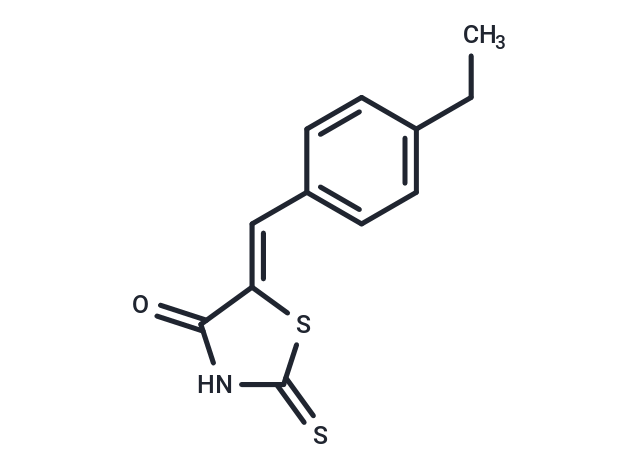Shopping Cart
- Remove All
 Your shopping cart is currently empty
Your shopping cart is currently empty

10058-F4 (c-Myc Inhibitor) is a cell-permeable thiazolidinone that specifically inhibits the c-Myc-Max interaction and prevents transactivation of c-Myc target gene expression; induces cell-cycle arrest and apoptosis.

| Pack Size | Price | Availability | Quantity |
|---|---|---|---|
| 5 mg | $43 | In Stock | |
| 10 mg | $68 | In Stock | |
| 25 mg | $109 | In Stock | |
| 50 mg | $166 | In Stock | |
| 100 mg | $243 | In Stock | |
| 500 mg | $597 | In Stock | |
| 1 mL x 10 mM (in DMSO) | $46 | In Stock |
| Description | 10058-F4 (c-Myc Inhibitor) is a cell-permeable thiazolidinone that specifically inhibits the c-Myc-Max interaction and prevents transactivation of c-Myc target gene expression; induces cell-cycle arrest and apoptosis. |
| In vitro | 10058-F4 caused AML cells to arrest in the G0/G1 phase, resulting in the down-regulation of c-Myc expression and the up-regulation of CDK inhibitors p21 and p27. Meanwhile, 10058-F4 induced apoptosis by activating the mitochondrial pathway, which resulted in the down-regulation of Bcl-2, up-regulation of Bax, release of cytochrome C from the cytoplasm, and cleavage of caspase3/7/9. In addition, 10058-F4 may induce myeloid differentiation by activating various transcription factors. Similarly, 10058-F4 induced apoptosis and differentiation of primary AML cells. 10058-F4 reduced c-Myc protein levels and inhibited proliferation of HepG2 cells, which may be related to the up-regulation of p21WAF1, a cell cycle protein-dependent kinase inhibitor, and the reduction of intracellular [alpha]-methylated fetoprotein. 10058-F4 also down-regulated the transcriptional level of human telomerase and reverse transcriptase. 10058-F4 also down-regulated the transcriptional level of human telomerase. reverse transcriptase downregulation. In addition to inhibiting the proliferation of HepG2 cells, 10058-F4 enhanced their sensitivity to conventional chemotherapeutic agents, adriamycin, 5-fluorouracil and cisplatin. |
| In vivo | 10058-F4 caused AML cells to arrest in the G0/G1 phase, resulting in the down-regulation of c-Myc expression and the up-regulation of CDK inhibitors p21 and p27. Meanwhile, 10058-F4 induced apoptosis by activating the mitochondrial pathway, which resulted in the down-regulation of Bcl-2, up-regulation of Bax, release of cytochrome C from the cytoplasm, and cleavage of caspase3/7/9. In addition, 10058-F4 may induce myeloid differentiation by activating various transcription factors. Similarly, 10058-F4 induced apoptosis and differentiation of primary AML cells. 10058-F4 reduced c-Myc protein levels and inhibited proliferation of HepG2 cells, which may be related to the up-regulation of p21WAF1, a cell cycle protein-dependent kinase inhibitor, and the reduction of intracellular [alpha]-methylated fetoprotein. 10058-F4 also down-regulated the transcriptional level of human telomerase and reverse transcriptase. 10058-F4 also down-regulated the transcriptional level of human telomerase. reverse transcriptase downregulation. In addition to inhibiting the proliferation of HepG2 cells, 10058-F4 enhanced their sensitivity to conventional chemotherapeutic agents, adriamycin, 5-fluorouracil and cisplatin. |
| Cell Research | Cells, plated in 96-well plates (105/mL for cell lines and 5 × 105/mL for primary leukemic cells), are treated in triplicate with indicated concentrations of 10058-F4. At various time points, 20 μL 5 mg/mL MTT is added to each well. After incubation at 37°C for 3 hours, the MTT medium is removed and 100 μL DMSO lysis buffer is added. The number of viable cells is assessed by the percentage of absorbance of treated cells relative to that of solvent controls, using 570-nm wavelength on a spectrophotometer.(Only for Reference) |
| Alias | c-Myc Inhibitor |
| Molecular Weight | 249.35 |
| Formula | C12H11NOS2 |
| Cas No. | 403811-55-2 |
| Smiles | CCC1=CC=C(\C=C2/SC(=S)NC2=O)C=C1 |
| Relative Density. | 1.33g/cm3 |
| Storage | Powder: -20°C for 3 years | In solvent: -80°C for 1 year | Shipping with blue ice. | ||||||||||||||||||||||||||||||||||||||||
| Solubility Information | H2O: < 1 mg/mL (insoluble or slightly soluble) DMSO: 65 mg/mL (260.68 mM), Sonication is recommended. Ethanol: 5 mg/mL (20.05 mM), Sonication is recommended. | ||||||||||||||||||||||||||||||||||||||||
Solution Preparation Table | |||||||||||||||||||||||||||||||||||||||||
Ethanol/DMSO
DMSO
| |||||||||||||||||||||||||||||||||||||||||

Copyright © 2015-2025 TargetMol Chemicals Inc. All Rights Reserved.